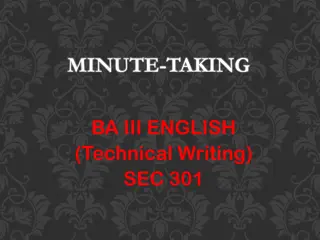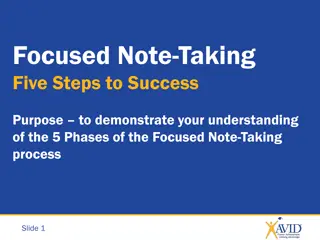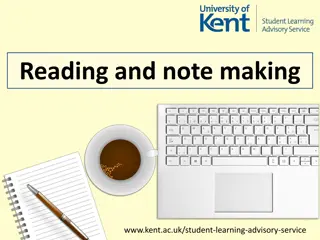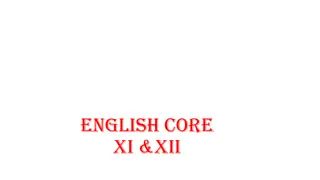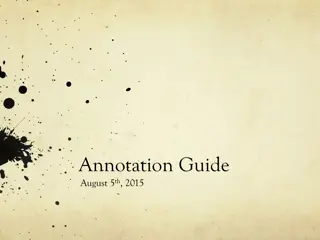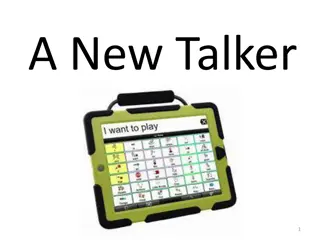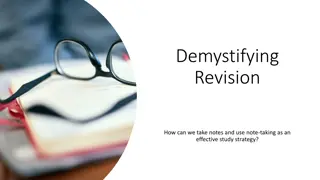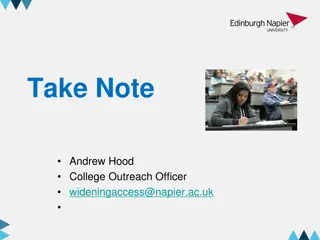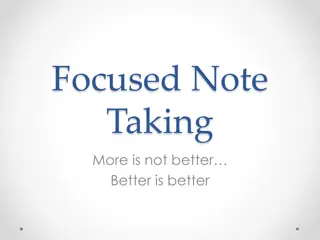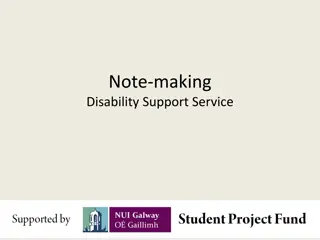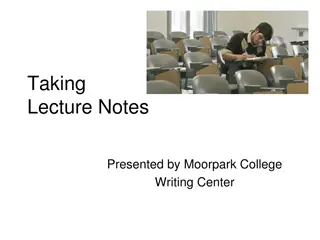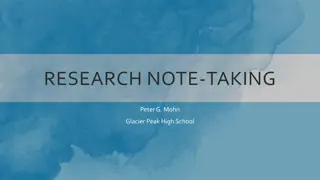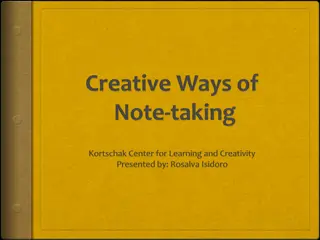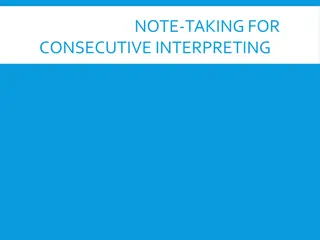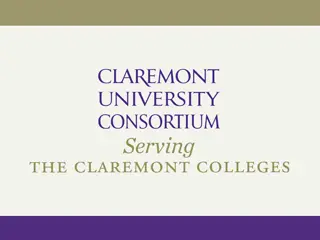Importance of Good Note-Taking Strategies in Learning
Taking good notes is essential for better understanding and retention of information. Research shows that handwritten notes are more effective than typed ones as they engage the brain better. To take good notes, preview the material, review previous notes, focus on key points, use visuals, and be consistent in your strategy. It is important to identify important points, listen for signal words, and summarize key information. Effective note-taking enhances learning outcomes and helps in better academic performance.
Download Presentation

Please find below an Image/Link to download the presentation.
The content on the website is provided AS IS for your information and personal use only. It may not be sold, licensed, or shared on other websites without obtaining consent from the author. Download presentation by click this link. If you encounter any issues during the download, it is possible that the publisher has removed the file from their server.
E N D
Presentation Transcript
Why Take Notes UNCFSU Learning Center Shannon Warren PAGE 1
Why Good Notes Matter Taking notes helps you to better pay attention in class. Numerous studies have shown that actively engaging with a course (i.e., note- taking) helps you to better understand, process, and recall information. Digital vs handwritten: Ina report by Duran and Frederick (2013), they found that students did better on assignments when they had handwritten/drawn notes vs typed notes. What they found is that it is easier for the human brain to understand and recall information when you physically write something. This is because your brain is more engaged when it is writing vs pressing a button. PAGE 2
Steps to Taking Good Notes Preview: Preview the material before class. Take notes from the assigned readings/videos. Review Previous Notes and Course Syllabus: Refresh yourself from the previous class material. Each class builds off the previous one. Know What Note-Taking Format to Use: Utilize the suggested note formatting guides (found in this lecture). Utilize Good Note-Taking Strategies: Determine what is important and jot that down. PAGE 3
Note-taking Strategies Focus: Focus on the main points that the professor makes in their lecture. Don t worry about copying word-for- word what your professor says. Main points/concepts/key terms are usually in italics, underlined, highlighted or easily identifiable on a slide. Remember, if you miss something, jot it down and define it later. Record: Whether it is a lecture or an assignment that you do outside of class, you should record questions that come up that you may want to follow up on and ask your professor about. Copying a question and answer helps you to recall that information later on and can be a great way to study. Visuals: Make sure that your notes are clear, concise, organized, and structured notes in order to ensure that you will understand them later on. You can also draw maps, diagrams, and other visuals that may help you better understand the material. Concise: You CANNOT copy everything you see on a slide. Be concise and use abbreviations, symbols, bullets and phrases instead of complete sentences. This will help your mind and hand to stay fresh during class and will help you access things easier and quicker after class. It will also help you focus on the main points of a lesson. Consistent: Be consistent with whatever note-taking strategy works for you. Changing your strategy can lead to confusion and inconsistency with the information that you are deciding to write down. For online lectures, you should not only use the tips above, but you should also jot down the timestamps of any important parts of the lecture that you may need to listen to again at a later date. PAGE 4
Determine what is important Introductory remarks often include summaries of overviews of main points. Listen for signal words/phrases like, There are four main or To sum up or A major reason why or One thing to remember is Repeated words or concepts are often important. Non-verbal cues like pointing, gestures, or a vocal emphasis on certain words, etc. can indicate important points. Final remarks and/or a wrap up of the class often provides a summary of the important points of the lecture. For online courses, consider watching online lectures in real time. Watching the lecture for the first time without pausing or rewinding can help force you to focus on what s important enough to write down. As recommended by the UNC Learning Center PAGE 5
Cornell Notes Outline Different Formats for notes Flowchart/ Concept Map Charting Method Sentence Method PAGE 6
Cornell Notes This style includes sections for the date, essential question, topic, notes, questions, and a summary. What are some things you notice about this style that is useful? PAGE 7
Outline Format An outline organizes the lecture by main points, allowing room for examples and details. PAGE 8
Flowchart/concept map A visual representation of notes is good for content that has an order or steps involved. PAGE 9
Charting Method A way to organize notes from lectures with a substantial amount of facts through dividing key topics into columns and recording facts underneath PAGE 10
Sentence Method One of the simplest forms of note taking, helpful for disseminating which information from a lecture is important by quickly covering details and information. PAGE 11
Sources Cited Duran K. S., Frederick C. M. (2013). Information comprehension: Handwritten vs. typed notes. Undergraduate Research Journal for the Human Sciences, 12. Effective Note-Taking in Class. The Learning Center at the University of North Carolina at Chapel Hill, https://learningcenter.unc.edu/tips-and-tools/effective-note-taking-in- class/#:~:text=If%20you%20are%20seeking%20conceptual%20information%2C%20focus%20on,wor ds%20or%20concepts%20you%20didn%E2%80%99t%20catch%20in%20class. Accessed 17 August 2022. PAGE 12



